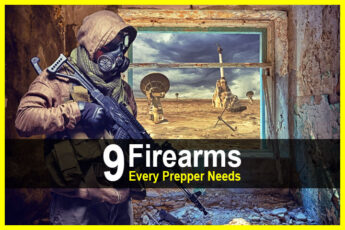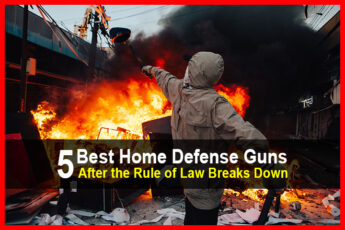Estimated reading time: 11 minutes
Many of us were raised in a family where hunting and shooting were a family tradition. It’s more than likely that anyone raised around rifles or handguns know the rules that govern gun safety. But as more and more people are turning to arming themselves for reasons ranging from personal security to hunting for the first time, gun safety is sometimes missed, ignored or simply not followed.
The results are often tragic. On average, 1300 children a year die from an accidental gunshot wound. There are just as many tragic accidents when adults have accidentally shot someone because they didn’t follow some of the most basic rules.
If you or someone you know has recently acquired a firearm, it makes a world of sense to stop and understand the importance of gun safety. When you look at some of the gun safety recommendations it’s easy to see that they all just make sense. It’s just a question of understanding them and thinking about why they’re so important.
The rules and gun safety principles outlined here are a collection of recommendations from the NRA and other shooting organizations dedicated to gun safety.
Want to save this post for later? Click Here to Pin It On Pinterest!
Gun Safety Fails:
1. Neglecting to take a gun safety course
The store where you purchased your rifle or handgun will often offer gun safety courses or can guide you to where you can find one. Those courses will no doubt cover all of the rules and discipline we’re about to outline, and it will allow you to actually practice what you’ve learned.
There are also online courses but training and gun safety on a gun range is ideal for many.
2. Forgetting to treat all guns as loaded
Many tragic accidents would have been avoided if people knew and practiced this basic rule of gun safety. Until you have personally checked and reassured yourself that the gun is not loaded, that the clip and the chamber is empty – assume it’s loaded and treat it that way.
3. Pointing the gun in a dangerous direction
This usually means you should have the gun pointed towards the ground or upwards towards the sky. The gun pointed to the ground is best, but if you are in a rocky area or an urban area with concrete sidewalks and asphalt roads –pointing it up is the best option to avoid the possibility of a ricochet off a hard surface.
Never, ever point a gun in the direction of anyone in your group or your surroundings. If you do this on a shooting range, it’s quite likely the Range Officer will tell you to leave immediately and you won’t be allowed back. Only point the gun at what you plan to shoot. There are too many examples of when someone has been severely wounded or even killed when a gun was pointed in their direction.
4. Failing to keep your finger off the trigger until ready to shoot
Some guns have light triggers especially rifles for competitive target shooting. Even a gun with a heavy trigger can accidentally fire following a trip, fall or surprising sound or movement causing you to involuntarily pull the trigger.
If you’ve ever seen a photo of a SWAT team in action, they usually have their trigger finger extended along the side of the trigger rather than on the trigger. Keep your finger off the trigger until you’re ready to shoot.
5. Ignoring what’s happening beyond the target
Guns have an extremely long range, especially rifles. In fact, most rifle rounds have a range measured in miles. It doesn’t matter how good a shot you are, everyone eventually misses. Think about what’s beyond your target. It’s not always possible to see what’s in the distance, especially when you’re hunting, but there are too many stories about errant gunshots killing children in cities.
If you’re not sure what’s beyond your target you shouldn’t take the shot. Here are the average ranges for various firearms and their respective ammunition, and this isn’t about the “effective” range for hunting or competition shooting. It’s about the “maximum” range a bullet can travel and kill any living thing it hits:
| CALIBER | MAXIMUM RANGE IN YARDS | MAXIMUM RANGE IN MILES |
| .22 LR | 2000 | 1 mile |
| 9MM (Glock) | 2400 | 1.3 miles |
| 5.56 NATO | 4375 | 2.5 miles |
| .308 Winchester | 7920 | 4.5 miles |
It can be a bit alarming to learn for the first time that most bullets fired can travel for miles. It’s why many of these rules are so critical to follow.
6. Assuming the safety makes your gun safe
Understanding exactly how to engage and disengage the safety is critical. Understanding how to recognize when it is on or off is just as important. Perhaps the most important thing to remember is that even if you think or know the safety is on, it can malfunction or be only half engaged. Never assume you can break any of the rules of gun safety just because you think the safety will keep you safe.
7. Failing to properly load and unload the gun
This is another reason a gun safety course is so important. If you have just purchased a firearm, the Range Safety Officer can instruct you on the proper way to load and unload. They’ll also show you how to make sure a round is not still in the firing chamber even though the clip is removed. An improperly loaded gun could misfire or worse. Understand the correct way to load and unload your specific rifle or handgun.
8. Not making sure you are loading the correct ammunition
Buying the wrong ammunition or confusing ammunition from another firearm you own can result in serious damage to the gun, and could cause the bullet to explode in the chamber or jam and shatter the barrel.
One suggestion that often appears is to color code boxes or clips and even mark on the clip what gauge and weapon the ammunition is intended for. If you own more than one firearm this will be a critical and constant practice.
9. Never checking to see if the barrel is clear before shooting
A lot can find its way into the barrel of gun. Dirt, debris, pieces of an errant round. Any debris in the barrel can affect the trajectory of the shot and in rare instances cause the bullet to jam in the barrel or damage the rifling.
What’s critical is to never look down the barrel from the muzzle. Disassemble the weapon and look down the barrel through the breach, or remove the barrel entirely. This should be a standard practice after every use when you have been actively firing, and before you head out for hunting.
10. Neglecting to keep all guns securely locked up and unloaded
This may be one of the most critical gun safety rules, particularly if you have children in your household. This is also a smart security measure in the event of burglary or break-ins.
There are a variety of gun safes that will allow you to safely store your firearms. Some are taller for stacking and storing both rifles and handguns. Others are smaller for handgun storage in a closet or other small area.
There are gun safes intended for travel in a car, and specialized guns safes for ammunition storage. Many of these ammunition storage safes are also fireproof to various degrees. It’s also recommended that ammunition and guns are stored in separate locations.
There are also trigger locks that can make a rifle or handgun impossible to fire without a key to unlock it. If you don’t want to invest in a gun safe of any size, at least buy a trigger lock.
11. Not understanding what to do if your gun fails to fire
This can happen for a variety of reasons. If your gun fails to fire, keep it aimed in the position you intended to fire or point it towards the ground. If the ground has hard surfaces like concrete, stone or asphalt –aim it upwards. Just remember if you fire into the air for any reason, that round is going to come down -somewhere.
The recommendation is to wait 30 seconds for any gun that misfires, and to then carefully unload it and try to remove the misfired round. Discard it safely and stop and think about the rest of the ammunition associated with the non-firing round.
It’s possible that the ammunition was old, damaged by moisture, defective or in some way compromised. One bad bullet may be an indication of problems with the rest of the ammunition in the box so think about the age of the ammo and how it was stored. If in doubt, throw them all out –safely.
Also, double-check the gun. A misfire could also be caused by a problem with the mechanics of the gun or some other maintenance issue. If you're not sure, cease firing and take your gun to a gun smith.
12. Ignoring the importance of cleaning your guns
Every gun should be cleaned after use. There are gun cleaning kits and videos that demonstrate the proper way to clean your particular firearm. Cleaning after every use will ensure your gun is as accurate as possible, and avoid other more serious problems in the future.
13. Not wearing ear and eye protection
You can’t enter a firing range to fire your gun without eye and ear protection. There’s a reason. Guns are loud and over time can cause ear damage. Especially with high-powered rifles that are usually supported by your shoulder with the receiver literally next to your ear.
Eye protection will also prevent any bits of shell casings or other debris from firing from getting into your eyes. And this isn’t just about gun ranges. Some people will wear ear and eye protection even when hunting. And some don't.
14. Not taking the time to understand the mechanics of your firearms
You should be able to disassemble and reassemble any gun you own. You’ll need to do this during routine cleaning but part of gun ownership is the ability to function as a gun mechanic.
You also need to understand all of the basic functions, controls and mechanisms to both accurately and safely shoot. New guns come with a manual outlining many of these details, or you can buy manuals and books with more information about your particular firearm.
15. Neglecting to have your gun serviced regularly
Most of us can’t or don’t have the time to master the craft of gunsmithing. The same applies to the vehicles we drive. Treat your guns the way you treat your vehicles. Understand and appreciate the importance of regular service to get your gun professionally cleaned, tuned-up, and possible repaired in the event of wear or accidental damage.
16. Altering or making modifications to any weapon
If you’re intrigued by additional features that can enhance the operation or impact of your gun, don’t do it yourself. Have it done professionally and understand the mechanics and service associated with any safe and approved modification. Homemade modifications can affect accuracy and function and be very dangerous if not done properly. It could also void any warranties associated with the firearm. Some are illegal.
17. Neglecting to respect your surroundings
When you fire a gun, you’re sending a bullet into the air traveling at hundreds of miles an hour over a range measured in miles. Think twice about what’s around you and respect your surroundings anytime you shoot.
18. Making the mistake of using your scope in place of binoculars
This is all too common and can result in you aiming at a person, building, or other object you would never intend to shoot. This goes back to only pointing your gun in a safe direction and avoiding anything you don’t intend to shoot. You may practice those principles on a regular basis, but using your scope as binoculars will contradict that rule.
19. Neglecting to obey all gun range rules
The rules are always posted as you enter any gun range. The Range Master is there to ensure everyone’s safety and enforce the rules. They are basically a recap of everything we’re covering here.
20. Thinking it okay to drink and shoot
Alcohol and driving don’t mix and neither does alcohol and guns. If you are taking any prescription medications that might impair your judgment, the same rule applies. Firing any gun can have significant consequences and it’s the last thing you should do with any kind of diminished capacity.
21. When in doubt, don’t pull the trigger
We mentioned this earlier but it’s one of the most significant rules. After a gun is fired there’s very little to stop a bullet. If you aren’t sure of your shot –don’t shoot.
Exception to the Rules?
An obvious observation is that in a crisis or the panic of self-defense, many of these rules would be hard if not impossible to follow. If your reason for owning a gun is personal self-defense in an emergency, at least make sure the gun is clean, stored securely, and that the proper ammunition is in the clip.
Most gun accidents occur when someone has access to an unsecured or unlocked gun. The best advice is to take that gun safety course and always try to follow these rules.
Like this post? Don't Forget to Pin It On Pinterest!






